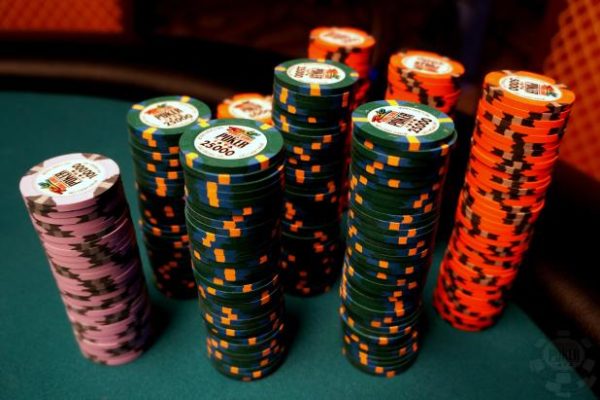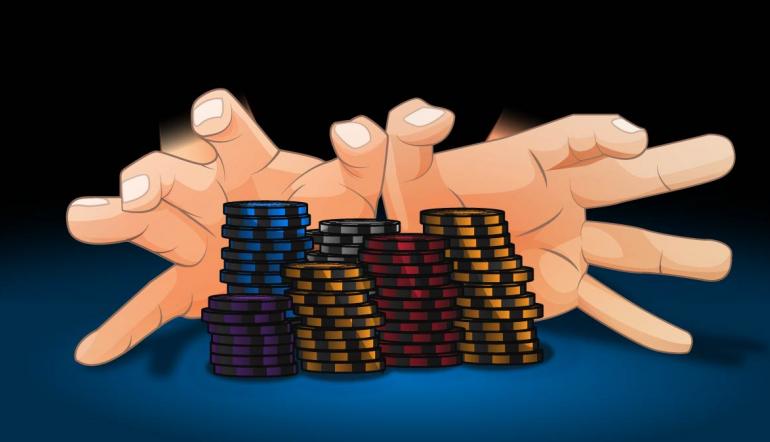How Many Chips Do You Give Out In Texas Holdem
- How Many Chips Do You Give Out In Texas Holdem Games
- How Many Chips Do You Start Out With In Texas Holdem
When I first started playing poker, I was solely an online player. In fact, it was about two years before I even thought about playing in a live game. Then, I discovered a local “Pub Poker” tournament and decided to give it a try. In my initial outing, I had no clue what it meant to “burn” a card or that it even existed. It took some rather “tough love” from my playing partners to figure out how it worked.
When you've run out of chips, you're out of the tournament. Where you are eliminated is where you finish in the tournament and determines if you win money and how much. In a standard Hold'em tournament, as mentioned, 10% to 20% of the field is paid out with most of the money reserved for the top spots. Values: 10 (many) - 20 (many) - 50 - 100 - 500 and later 1000. This is good for 10 players or more. Let's say 20 players has one buy in each. That's a total of 40 000 (stack is 2000 to begin with). When there is 4 players left, average chipstack is 10 000. If you change the 10's and 20's into 500's or 1000's, you'll see a reasonable amount of.
Eventually, I discovered that burning cards are an important part of Texas Hold’em and variant of poker that involves play over multiple streets. In fact, there is more than one reason cards are burned and each is an integral part of the game. This article will explain everything that I have learned about the subject so far.
There are up to 3 total burn cards in a Texas Hold’em poker hand. Before dealing the flop, turn, or river, the dealer is required to take the top card from the deck and burn (discard) it. The burn card is never to be shown to the players, as it could influence future decision-making. This practice is required in all multi-street games, not just Hold’em, whether at a casino or a casual home game. The purpose of the burn card is to prevent cheaters from gaining an advantage with marked cards.
Dealing a hand of Texas Hold’em is fairly simple and pretty much anyone can do it well enough to take their turn to deal if playing a Texas Hold ‘Em game at home with some friends. This article will walk you through the important things you need to do in order to properly deal Texas Hold’em, from the start of the hand through the conclusion.
Do You Burn a Card Before Dealing to the Players?
No. Once the deck is cut, the dealer deals the first card directly off the top of the deck. The only time a card is burned is immediately before dealing the flop, turn, or river. No more than 3 cards should ever be burned during a hand of poker.
What Is the Exact Sequence the Cards Are Dealt?
The playing of a poker hand generally adheres to the following 6 step ritual. The following routine is the same no matter where or who you play with. Stick to this sequence and you can be sure you are burning the correct cards at the right times.
- The Shuffle Before playing, the cards are generally shuffled at least 4 times.
- The Cut In most games, the player to the dealer’s right is given the option of cutting the cards.This is where the deck is split into two halves with the bottom half being placed over and on top of the top half. In casinos, the dealer almost always does the cut. You are not generally allowed to ask to cut the cards since the casino wants the players only to be able to touch the cards dealt to them.
- The Deal The dealer then begins dealing to the Small Blind and continues around the table in a clockwise fashion until everyone has the required number of cards (2 for Texas hold’em).
- The Flop After the pre-flop betting round concludes, the dealer then burns 1 card and places it face down on the table in front of him, near where the deck of cards rests. He then deals the next 3 cards face up on the table, called the “flop”.
- The Turn Once the action is closed on the flop, the dealer then burns another card and places the next card (just 1) face up on the table, called the “turn”.
- The River After the action closes on the turn, the dealer burns the final cards and places the next card in the deck on the table, called the “turn”. This is the third and final burn card.
Where Do I Put the Burn Cards While Dealing?
Generally, you can put them anywhere you want, just not back in the deck. Sometimes, I see dealers set them in the muck. My advice is to have a nice neat pile next to the spot you keep the deck. That way, as you deal, everyone at the table can be sure that you have burned the cards like you are supposed to. This simple way of storing the cards will end a lot of disputes over the burn cards. Even so, everyone occasionally makes a mistake and forgets to deal to a particular person or even has a burn card oversight.
What If I Forget to Burn a Card?
It depends on when someone notices the card wasn’t burned. If the betting for the round has already been completed, then the actions stand and you continue on as normal. If someone notices before a bet is made, then the card that was supposed to be the burn is set aside as a new card is dealt.
If there is any dispute as to whether a card was burned or not, the casino floor is typically called over for a decision. In home games, there is no hard and fast rule for dealing with this type of dispute. Hopefully, your buddies are friendly enough to just come to a mutually agreed upon decision, so you can move on.
If you are looking for a simple way to resolve the issue, here is something I’ve seen done in the past. Basically, you just put the incorrectly dealt card back into the remaining undealt cards and reshuffle the deck. Then, continue as normal and burn and turn the next street. This ends all conversation about whether someone was cheating or not by not burning a card.
Other Benefits of the Burn Cards
While burn cards were originally intended to counter card marking, there are two additional secondary uses.
- Preventing Second Dealing The first is another anti-cheating purpose to prevent something known as second dealing. This is when a player knows the top and then chooses to deal the second card instead, hoping for a better outcome than the first card would have given. A good example of this is when either the dealer or another player has a flush or straight draw. Second dealing effectively gives that player two changes at making their hand, unfairly increasing their odds of winning.
- Correcting Irregularities I really like this rule, as it speeds up the game. An example of an irregularity is when a card is accidentally flashed or turned over during dealing. In this case, the dealer is to pull the offending card aside to be used as the burn card for the flop. The player who was supposed to get the misdealt card then receives a replacement once all of the other cards have been distributed. An exception to the rule is when the card is flashed or turned over while being given to players in the blinds. In this case, a misdeal is announced, and the cards have to be reshuffled to start again.

Do Burn Cards Affect Probabilities?
No. Probabilities are determined by figuring out the math based on known cards and unknown cards. It doesn’t matter where the unknown cards are, whether in the muck, in the burn pile, or in another player’s hand. Unknown is unknown. The only way that the probabilities can be affected by the burn card is that it is seen by someone, either deliberately or accidentally.
If the Discarded Cards Are Named Burn Cards, What Are the Flop Turn and River Called?
Community, or common, cards. These cards are shared by everyone else at the table and used to make the best 5 card hand. The two cards that you hold in your hand are called “hole cards”.
Summary
After reading this, you now know exactly how to deal the cards in Texas Hold’em, including when to burn a card and where to put them during the hand. My advice for dealing newbies is to take it slow during your turn to deal, and don’t be afraid to ask if you are unsure about something. Before you know it, pitching the cards will become second nature, and you will be able to do it without even thinking.
/standard-poker-chip-denominations-412236-FINAL-5bf2f796c9e77c005118f97e.png)
Good luck at the tables and thanks for reading.
OBJECTIVE: To become a winner you should make up the highest possible poker hand of five cards, using the two initially dealt cards and the five community cards.
NUMBER OF PLAYERS: 2-10 players

NUMBER OF CARDS: 52- deck cards
RANK OF CARDS: A-K-Q-J-10-9-8-7-6-5-4-3-2
THE DEAL: Every player is dealt two cards face down which is commonly called ‘hole cards’.
TYPE OF GAME: Casino
AUDIENCE: Adults
Introduction to Texas Hold ‘Em
How to Play
How Many Chips Do You Give Out In Texas Holdem Games
First Round Betting: The Pre-Flop
Second Round Betting: The Flop
Third & Fourth Round Betting: The Turn & The River
How Many Chips Do You Start Out With In Texas Holdem
Ties
Pairs– if two players are tied for highest pairs a “kicker” or the next highest-ranking card is used to determine the winner. You continue until one player has a higher-ranking card or both are determined to have the same exact hand, in which case the pot is split.
Two pairs– in this tie, the higher ranked pair wins, if top pairs are equal in rank you move to the next pair, then move to kickers if necessary.
Three of a kind – higher ranking card takes the pot.
Straights – the straight with the highest-ranking card wins; if both straights are the same the pot is split.
Flush – The flush with the highest-ranking card wins, if the same you move to the next card till a winner is found or hands are the same. If hands are the same split the pot.
Full house – the hand with the higher ranking three cards wins.
Four of a kind – the higher ranking set of four wins.
Straight flush – ties are broken the same as a regular straight.
Royal Flush – split the pot.